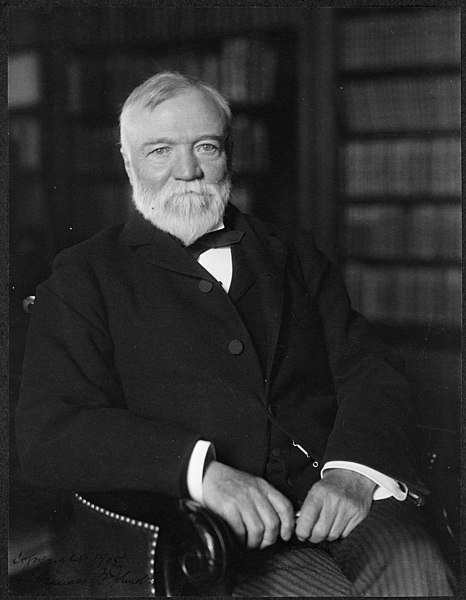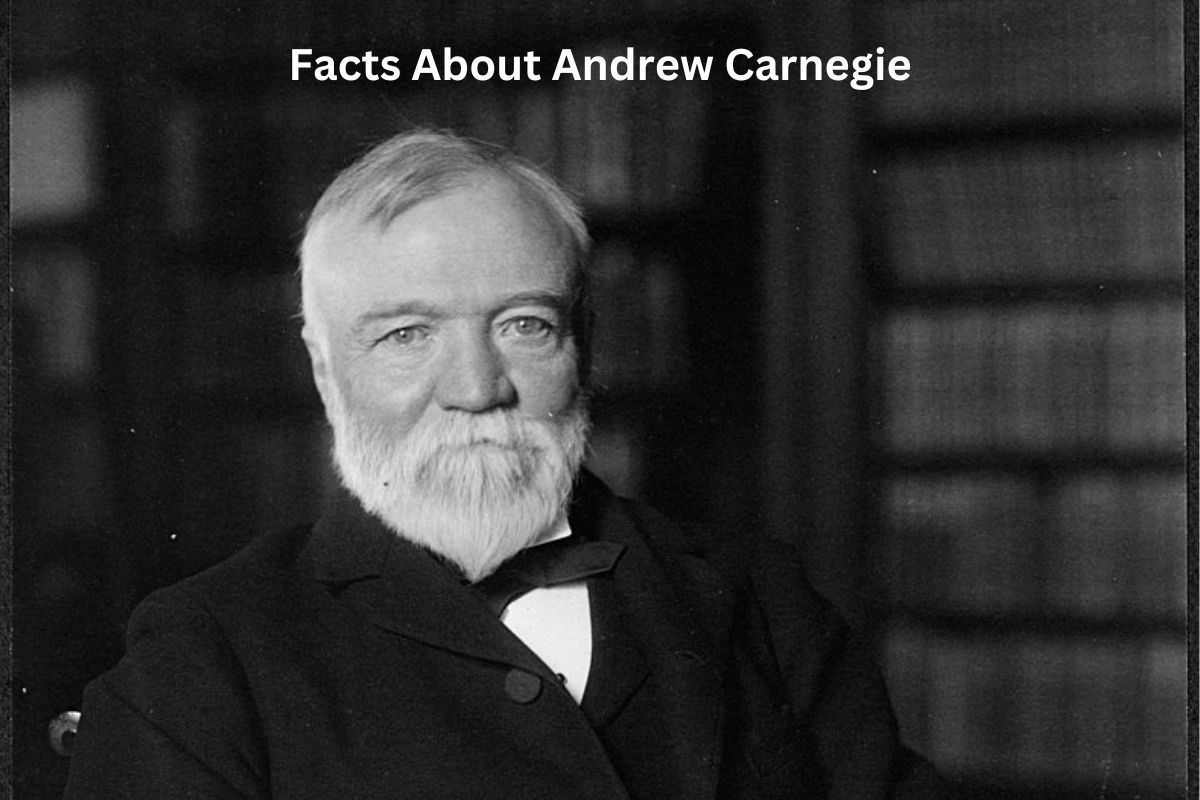Andrew Carnegie, born on November 25, 1835, in Dunfermline, Scotland, was a prominent American industrialist and philanthropist.
His journey from humble beginnings as an immigrant child to becoming one of the wealthiest individuals of his time is a remarkable tale of success in the late 19th and early 20th centuries.
Carnegie’s legacy is characterized by his pioneering role in the steel industry, his fervent belief in philanthropy, and his substantial contributions to education, culture, and peace initiatives that continue to benefit society today.
Andrew Carnegie Facts
1. Born in Scotland on November 25, 1835
Andrew Carnegie was born on November 25, 1835, in the town of Dunfermline, Scotland. He was born into a working-class family, and his early years were marked by poverty and economic hardship.

2. Immigrated to the United States as a child
In 1848, when Carnegie was just a child of 13, his family made the life-altering decision to immigrate to the United States in search of better opportunities.
Also Read: Andrew Carnegie Timeline
They settled in Allegheny City, now part of Pittsburgh, Pennsylvania. The Carnegies were one of many immigrant families seeking a new beginning in America during the 19th century.
3. Made his fortune in the steel industry
Andrew Carnegie’s rise to wealth and prominence came through his involvement in the steel industry. He began his career as a bobbin boy in a cotton factory and later worked as a telegraph messenger boy, gaining exposure to the growing industrial landscape of Pittsburgh.
He soon recognized the potential of the steel industry and started working at the Pennsylvania Railroad, where he learned about the production and use of iron and steel.
Also Read: Accomplishments of Andrew Carnegie
Carnegie’s pivotal moment came when he invested in the production of iron bridges during the Civil War. His entrepreneurial spirit and keen business acumen led him to establish various steel-related businesses.
Over time, he consolidated these ventures into the Carnegie Steel Company, which became one of the largest and most successful steel producers in the United States.
Carnegie’s innovations and adoption of the Bessemer process, a more efficient method of producing steel, contributed significantly to the growth of the American steel industry. His success in the steel industry ultimately propelled him to become one of the wealthiest individuals of his era.

4. Founded Carnegie Steel Company
Andrew Carnegie’s Carnegie Steel Company became a dominant force in the American steel industry by the late 19th century.
Carnegie’s focus on cost efficiency, vertical integration (controlling all aspects of production, from raw materials to distribution), and the adoption of innovative technologies like the Bessemer process allowed his company to produce steel at a lower cost and higher quality than competitors.
This made Carnegie Steel highly profitable and positioned Carnegie as one of the wealthiest individuals in the world.
5. Sold his company to J.P. Morgan in 1901
After selling Carnegie Steel to financier J.P. Morgan in 1901 for $480 million (equivalent to billions today), Carnegie shifted his attention toward philanthropy.
He believed in the idea of “the Gospel of Wealth,” which held that the rich had a moral obligation to use their wealth for the betterment of society. Carnegie saw philanthropy as a means to address societal issues and promote the welfare of others.
6. Became a prominent philanthropist
- Andrew Carnegie’s philanthropic donations during his lifetime amounted to hundreds of millions of dollars, making him one of the most generous philanthropists in history. His wealth allowed him to fund a wide range of initiatives and organizations, including:
- Carnegie Libraries: The construction of over 2,500 public libraries in the United States and other countries.
- Carnegie Endowment for International Peace: Supporting efforts to promote peace and diplomacy on a global scale.
- Carnegie Mellon University: Providing substantial funding to establish and support this renowned research university.
- Carnegie Hall: Contributing to the construction and development of the famous concert hall in New York City.
- Carnegie Museums: Funding the creation of museums, including the Carnegie Museum of Natural History in Pittsburgh.
Andrew Carnegie’s commitment to philanthropy and the idea of using wealth for the benefit of society has had a lasting and transformative impact on education, culture, and peace efforts worldwide.
His example continues to inspire others to engage in philanthropy and contribute to the betterment of their communities.

7. Funded the construction of thousands of libraries
One of Andrew Carnegie’s most enduring philanthropic legacies is his funding of public libraries. He donated vast sums of money to build more than 2,500 libraries across the United States and in other parts of the world.
These Carnegie libraries were designed to be free and accessible to the public, promoting education and knowledge. This initiative had a profound impact on the spread of literacy and learning, making books and resources available to countless communities, large and small, in both urban and rural areas.
Many of these libraries still exist today, and they continue to serve as vital educational and cultural centers in their communities.
Carnegie’s library donations totaled approximately $60 million, a significant portion of his wealth. His dedication to providing access to knowledge through libraries has left a lasting legacy and contributed to the intellectual and cultural development of countless individuals and communities.
8. Advocated for international peace
Andrew Carnegie was a strong advocate for international peace. He established the Carnegie Endowment for International Peace in 1910 with an initial donation of $10 million.
He also funded the construction of the Peace Palace in The Hague, which houses the International Court of Justice.
Carnegie promoted diplomacy, arbitration, and negotiation over armed conflict and supported various peace initiatives and organizations throughout his life. His efforts continue to influence global peace initiatives today.
9. Wrote the book “The Gospel of Wealth”
Andrew Carnegie was not only a successful industrialist and philanthropist but also an author. One of his notable works is “The Gospel of Wealth,” which he published in 1889. In this essay, Carnegie articulated his views on wealth and philanthropy.
He argued that the wealthy had a moral duty to use their fortunes to benefit society rather than merely accumulating wealth for personal gain. He believed that by doing so, they could help address social issues and contribute to the greater good.
10. Died on August 11, 1919, leaving a lasting legacy in education and philanthropy
Andrew Carnegie passed away on August 11, 1919, in Lenox, Massachusetts. His legacy is deeply intertwined with his philanthropic contributions. Through his extensive donations, he left an indelible mark on American and global society.
His funding of libraries, universities, museums, and cultural institutions, as well as his contributions to peace initiatives, continues to benefit communities and promote education, culture, and peace long after his death.
